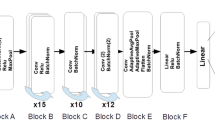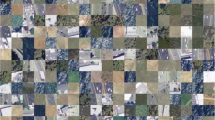Abstract
For satellite image processing using deep learning, the images are first resized to one standard size and then applied to the convolutional neural network(CNN) model to train and test the model. The primary step of preprocessing the images is resizing, which is done by various approaches such as bicubic interpolation, bilinear interpolation, and nearest neighbour interpolation. The impact of resizing technique on the performance of the deep learning model is unexplored yet. In the proposed work, the authors have proposed a CNN architecture and investigated the impact of resizing technique on the performance of trained deep learning model and evaluating the uncertainty of classification. The classification performed by the proposed model is a multilabel classification problem with 6 possible labels denoting land coverage. The proposed model is trained using SAT-6 dataset images. The SAT-6 dataset contains images of size \(28 \times 28\), which are resized to \(56 \times 56\) using nearest neighbor interpolation for the training of the model, and testing is done using the aforementioned three interpolation techniques. Finally, the model performance is evaluated in term of specificity, sensitivity, accuracy, and uncertainty of the classification. This paper’s contribution is twofold – first, to put forward a generic model that will help other remote-sensing applications, and second to evaluate the uncertainty of the classification task by varying the image resizing technique.







Similar content being viewed by others
References
Kavitha, P. K., and P. V. Saraswathi. ”Content based satellite image retrieval system using fuzzy clustering.” Journal of Ambient Intelligence and Humanized Computing pp. 1–12, 2020.
G.-S. Xia, J. Hu, F. Hu, B. Shi, X. Bai, Y. Zhong, L. Zhang, and X. Lu, ”AID: A benchmark data set for performance evaluation of aerial scene classification,” IEEE Trans. Geosci. Remote Sens., vol. 55, no. 7, pp. 3965-3981, 2017.
E. Maggiori, Y. Tarabalka, G. Charpiat, and P. Alliez, ”Convolutional neural networks for large-scale remote-sensing image classification,” IEEE Trans. Geosci. Remote Sens., vol. 55, no. 2, pp. 645-657, 2017.
M. Carranza-García, J. García-Gutiérrez, and J. Riquelme, ”A framework for evaluating land use and land cover classification using convolutional neural networks,” Remote Sens., vol. 11, no. 3, p. 274, 2019.
Xu, L., Chen, Y., Pan, J. and Gao, A., Multi-structure joint decision-making approach for land use classification of high-resolution remote sensing images based on CNNs. IEEE Access, vol. 8, pp.42848-42863, 2020.
T. Ojala, M. Pietikainen, and T. Maenpaa, ”Multiresolution gray-scale and rotation invariant texture classification with local binary patterns,” IEEE Trans. Pattern Anal. Mach. Intell., vol. 24, no. 7, pp. 971-987, 2002.
D. G. Lowe, ”Distinctive image features from scale-invariant keypoints,” Int. J. Comput. Vis., vol. 60, no. 2, pp. 91-110, 2004.
Y. Yang and S. Newsam, ”Bag-of-visual-words and spatial extensions for land-use classification,” in Proc. 18th SIGSPATIAL Int. Conf. Adv. Geographic Inf. Syst. (GIS), 2010, pp. 270-279.
K. Lee, Z. Hyung, and J. Nam, ”Acoustic scene classification using sparse feature learning and event-based pooling,” in Proc. IEEE Workshop Appl. Signal Process. Audio Acoust., Oct. 2013, pp. 1-4.
Q. Zou, L. Ni, T. Zhang, and Q. Wang, ”Deep learning based feature selection for remote sensing scene classification,” IEEE Geosci. Remote Sens. Lett., vol. 12, no. 11, pp. 2321-2325, 2015.
G. Cheng, Z. Li, X. Yao, L. Guo, and Z. Wei, ”Remote sensing image scene classification using bag of convolutional features,” IEEE Geosci. Remote Sens. Lett., vol. 14, no. 10, pp. 1735-1739, 2017.
F. Lv, M. Han, and T. Qiu, ”Remote sensing image classification based on ensemble extreme learning machine with stacked autoencoder,” IEEE Access, vol. 5, pp. 9021-9031, 2017
Paisitkriangkrai, S., Sherrah, J., Janney, P., Hengel, A., Semantic labeling of aerial and satellite imagery. IEEE Journal of Selected Topics in Applied Earth Observations and Remote Sensing, vol.7, no. 9, pp.1-14, 2016.
Volpi, M., Tuia, D., ”Dense semantic labeling of subdecimeter resolution images with convolutional neural networks, ”IEEE Transactions on Geoscience and Remote Sensing, vol. 55, no. 2, pp. 881-893, 2017.
Zhu, X.X., Tuia, D., Mou, L., Xia, G.S., Zhang, L., Xu, F., Fraundorfer, F., Deep learning in remote sensing: a comprehensive review and list of resources. IEEE Geoscience and Remote Sensing Magazine, Vol. 5, pp. 8-36, 2017.
S. Basu, S. Ganguly, S. Mukhopadhyay, R. DiBiano, M. Karki, and R. Nemani, ”Deepsat-A Learning Framework for Satellite Imagery,” arXiv preprint, vol. arXiv:1509.03602, September 2015.
Y. Zhong, F. Fei, Y. Liu, B. Zhao, H. Jiao, and L. Zhang, ”SatCNN: Satellite Image Dataset Classification using Agile Convolutional NeuralNetworks,” Remote Sensing Letters, vol. 8, no. 2, p. 136-145, 2017.
Q. Liu, S. Basu, S. Ganguly, S. Mukhopadhyay, R. DiBiano, M. Karki, and R. Nemani, ”DeepSat V2: Feature Augmented Convolutional Neural Nets for Satellite Image Classification,” Remote Sensing Letters, Nov 2019.
Z. Gong, P. Zhong, Y. Yu, and W. Hu, ”Diversity-Promoting Deep Structural Metric Learning for Remote Sensing Scene Classification,” IEEE Transactions on Geoscience and Remote Sensing, January 2018.
Liu, Q., Basu, S., Ganguly, S., Mukhopadhyay, S., DiBiano, R., Karki, M. and Nemani, R., 2020. Deepsat v2: feature augmented convolutional neural nets for satellite image classification. Remote Sensing Letters, 11(2), pp.156-165.
Pires de Lima, Rafael, and Kurt Marfurt. ”Convolutional neural network for remote-sensing scene classification: Transfer learning analysis.” Remote Sensing, vol. 12, no. 1, pp.86, 2020.
Han D., ”Comparison of commonly used image interpolation methods, ” In Proceedings of the 2nd international conference on computer science and electronics engineering, pp. 1556-1559, Mar 2013, Atlantis Press.
Rukundo O, Cao H., ”Nearest neighbor value interpolation, ” International Journal of Advanced Computer Science and Applications, vol. 3, no. 4, pp.25-30, 2012.
Garg, N., Yadav, S. and Aswal, D.K., 2019. Monte Carlo simulation in uncertainty evaluation: strategy, implications and future prospects. Mapan, 34(3), pp.299-304.
Garg, N. and Chauhan, B.S., 2020. Measurement Uncertainty in Vibration Calibration in Frequency Range of 5 Hz to 10 kHz. MAPAN, 35(3), pp.397-405.
Kumar, A. and Misra, D.K., 2020. A review on the statistical methods and implementation to homogeneity assessment of certified reference materials in relation to uncertainty. MAPAN, pp.1-14.
Tötsch, N. and Hoffmann, D., Classifier uncertainty: evidence, potential impact, and probabilistic treatment. arXiv preprint arXiv:2006.11105, 2020.
WWW2. NAIP. http://www.fsa.usda.gov/Internet/FSA_File/naip_2009_info_final.pdf.
C. L. Zhong Ma, Zhuping Wang and X. Liu, ”Satellite Imagery Classification based on Deep Convolution Network,” International Journal of Computer and Information Engineering, vol. 10, no. 6, pp. 1156-1159, 2016.
Author information
Authors and Affiliations
Corresponding author
Additional information
Publisher's Note
Springer Nature remains neutral with regard to jurisdictional claims in published maps and institutional affiliations.
Rights and permissions
About this article
Cite this article
Rathee, N., Pahal, S. & Sheoran, D. Evaluating the Uncertainty of Classification Due to Image Resizing Techniques for Satellite Image Classification . MAPAN 36, 243–251 (2021). https://doi.org/10.1007/s12647-021-00456-y
Received:
Accepted:
Published:
Issue Date:
DOI: https://doi.org/10.1007/s12647-021-00456-y




